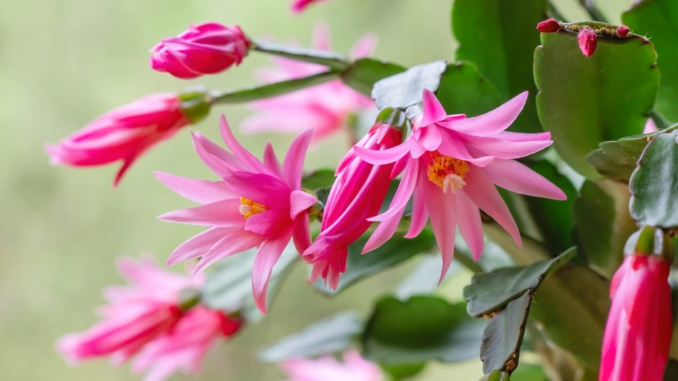

by Bryan Fischer, Horticulturist, Gardens on Spring Creek
Discussed previously in this column, holiday cacti are classic, if poorly-understood additions to houseplant collections in our region. Some holiday cacti can re-bloom lightly (and at odd times), so it’s wise to check several features before assuming you have the correct identity of your cactus.
In addition to the previously discussed Thanksgiving and Christmas cacti, a third type of cactus, commonly referred to as Easter cactus, can be found for sale occasionally in our region, often at garden centers or in grocery stores. A late-winter-to-spring bloomer with slightly different cultural requirements set these plants (Schlumbergera or Rhipsalidopsis gaertneri, depending on who you ask) apart from their early-winter-blooming relatives (other species and hybrids in the Schlumbergera genus: Schlumbergera truncata and Schulmbergera x).
Distinguished most easily from winter-blooming relatives by their spring display, Easter cacti also provide a few other clues to aid in identification. Smaller in overall size when compared to their peers, these attractive plants have a more upright, arching form and blooms with radial symmetry, rather than the bilateral symmetry employed by Thanksgiving and Christmas cacti. The flowers produced by Easter cacti are also considerably flatter than other holiday cacti, which typically have a distinct, tubelike shape before the face of their blooms.
Additionally, in opposition to the pointed leaf edges of Thanksgiving cacti, Easter cacti have the smoothest, most rounded leaf edges of the commonly seen holiday cacti. Most helpful to me, the tops of leaf segments are also tipped with tufts of very short “glochids” that appear like hairs to the naked eye.
I prefer the refined, star-shaped blooms of Easter cacti to their gaudier counterparts. Whites, pinks, oranges, and reds, make excellent focal points in our homes at a time when it is so easy to appreciate the merits of a vibrant floral display. Each bloom is surprisingly long-lived, closing each night and reopening each morning, with some plants blooming for weeks or more.
Follow these steps to ensure that your holiday cacti bloom:
- Sustain the three conditions below for at least four weeks simultaneously:
- Temperatures of 60 to 70 degrees, with 60 to 65 at night preferable
- Uninterrupted darkness for 14 hours per day is essential to set buds
- This naturally begins in mid-November in Northern Colorado
- You can force this process by covering plant / excluding light overnight
Bud setting for Easter cacti occurs a couple of months later, and relies on the steps above for holiday cacti, PLUS:
- A sustained, four-week drop in temperature to 55 degrees after the above requirements are met:
- Consider placing plants near your coolest window
- Continued uninterrupted long nights (14+ hours) through the chilling period
- Drier than average soil – reduce watering to just enough to prevent leaf shriveling
Then return your plant to room temperature by mid-February, when budget should be set and long nights no longer required; return to standard watering.
Support Northern Colorado Journalism
Show your support for North Forty News by helping us produce more content. It's a kind and simple gesture that will help us continue to bring more content to you.
BONUS - Donors get a link in their receipt to sign up for our once-per-week instant text messaging alert. Get your e-copy of North Forty News the moment it is released!
Click to Donate
